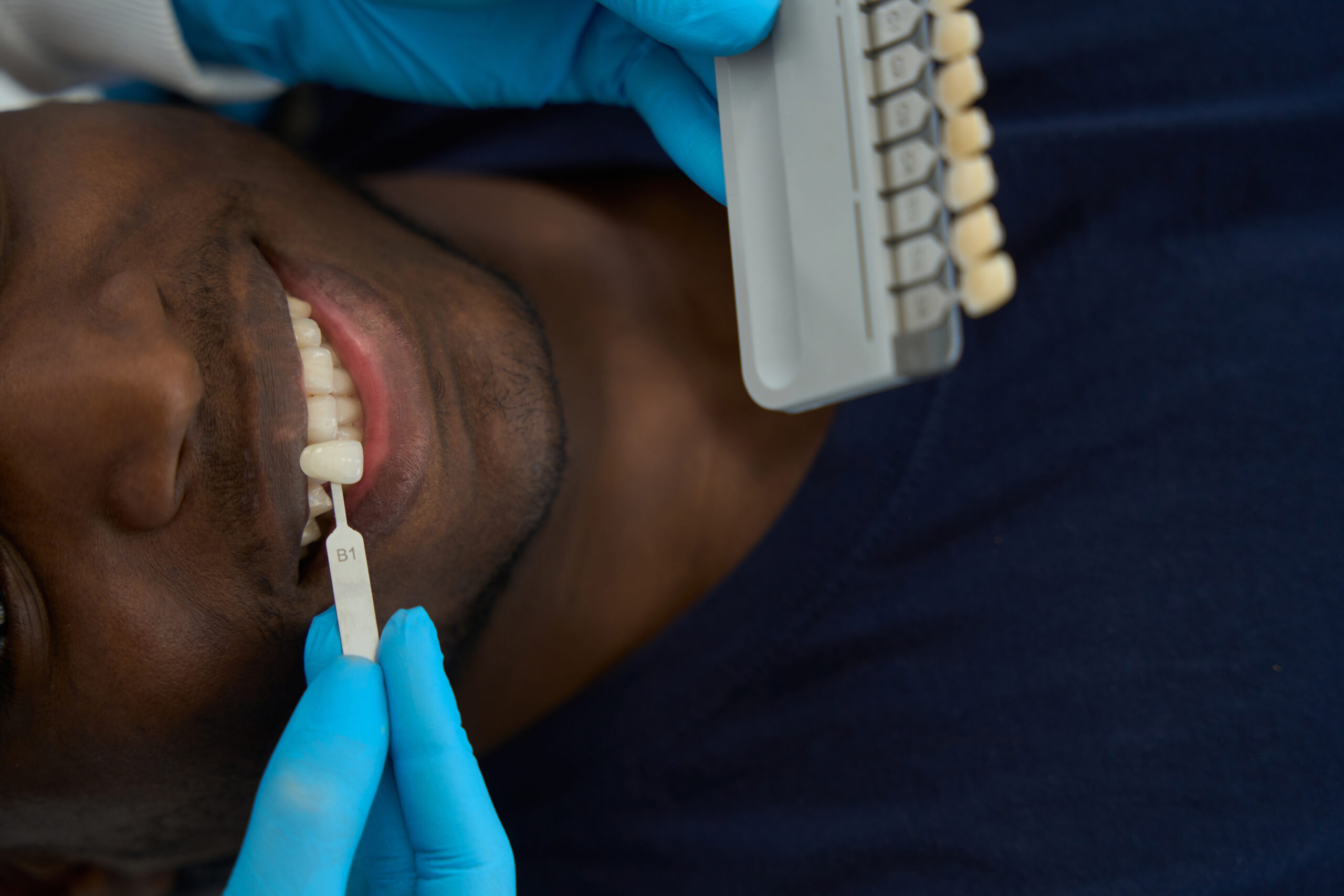If you have been weighing different ways to replace missing teeth, you have likely come across dental bridge placement as an appealing, dependable option. At Vivid Dental Raleigh, we believe in offering a comprehensive, empathetic, and supportive environment so you feel empowered in making the best decisions for your oral health. In this detailed guide, you will learn what a dental bridge is, how it works, and why it might be the right solution for you. You will also discover the unique benefits of choosing our high‑tech, aesthetic‑focused cosmetic and general dentistry approach.
Consider dental bridge placement
Dental bridge placement involves using a custom-made, natural-looking prosthetic to fill the space where teeth are missing. A dental bridge is anchored in place by crowns fitted over the healthy teeth or dental implants on either side of the gap. Once placed, the bridge looks and functions much like your original teeth.
Making an informed choice is vital because your oral health affects not only your daily comfort, but also your long-term well-being. Research shows that missing teeth can impact your overall confidence, chewing efficiency, and even the alignment of your remaining teeth (Colgate). By considering dental bridge placement, you aim to restore your smile’s aesthetics, regain proper bite function, and promote better oral health.
When you are exploring this option, you might wonder if these restorations will be comfortable, whether they will last for years, and how you can preserve them. At Vivid Dental Raleigh, we understand these concerns. We also recognize you may be seeking a provider who not only excels in technical skill but also offers individualized care that acknowledges your unique challenges and goals. By focusing on a supportive atmosphere, we ensure you feel confident in choosing a dental bridge to address missing teeth.
Recognize the unique challenges
Losing a tooth, or multiple teeth, can create emotional and practical obstacles. You may grapple with concerns about your self-esteem, chewing abilities, or speech patterns. You could also be weighed down by the fear of invasive procedures or lengthy healing times. These feelings are common, and it is important to acknowledge them so you can work through any apprehensions with honesty and support.
- Emotional impact: A gap in your smile can be a source of self-consciousness, which can influence your social interactions or professional life. A good dental bridge placement can help restore your self-esteem.
- Physical challenges: Missing teeth can lead to shifting in the remaining teeth and possible discomfort when you bite or chew. The alignment changes might even bring stress to your jaw joints.
- Lifestyle adjustments: Adapting to a new prosthetic takes time and patience. You may need to modify your diet initially and practice different oral hygiene methods to keep your bridge clean.
At Vivid Dental Raleigh, we prioritize a treatment approach that meets your distinctive needs. Our team understands how entwined emotional well-being is with physical health, which is why our practice focuses on empathy, reassurance, and comprehensive care. This sets the foundation for establishing comfortable, individualized plans that provide the support necessary for lasting results.
Explore your bridge options
You have a variety of bridge types to choose from, each designed to suit different clinical scenarios and patient preferences (Healthline). Here are some popular bridge options:
- Traditional dental bridge
- The most common type, involving one or more pontics (artificial teeth) secured by crowns on the healthy teeth on both sides of the gap.
- Made from materials like porcelain fused to ceramic or metal.
- Ideal if you have natural teeth remaining on both sides of the missing tooth or teeth.
- Cantilever dental bridge
- Similar to traditional bridges, but anchored on only one healthy tooth instead of both sides.
- Useful when there is only one suitable abutment tooth adjacent to the gap.
- Can place extra stress on the supporting tooth, so careful evaluation is required.
- Maryland dental bridge
- Also known as a resin‑bonded bridge, it uses a metal or porcelain framework with “wings” bonded to the back of adjacent teeth.
- It is a more conservative approach, preserving more of the tooth structure.
- Typically used to replace missing front teeth.
- Implant-supported dental bridge
- Relies on implants placed in the jawbone, providing a strong, stable foundation.
- Often recommended if you are missing multiple teeth, as it does not rely on the strength of natural abutment teeth.
- Requires two or more procedures over several months to place the implants and attach the bridge.
If you are thinking about combining the benefits of a bridge with the added stability of implants, you can speak to our team about our implant supported bridge service. This service offers dependable strength and comfort, particularly for those who are missing more than one tooth in a row.
Understand the benefits
Opting for a dental bridge can bring numerous advantages that streamline your everyday life:
- Improved appearance: Dental bridges help you reclaim a natural smile. They also prevent facial sagging that sometimes occurs when teeth are missing.
- Enhanced functioning: By restoring your smile’s structure, bridges enable you to chew and speak more efficiently.
- Preserving tooth alignment: Replacing missing teeth prevents neighboring teeth from drifting into the open space, helping maintain a healthier bite and jaw alignment (Cleveland Clinic).
- Comfort and convenience: A well-fitted bridge generally feels more comfortable and stable than dentures, all without needing to remove it for cleaning.
- Long-term solution: With proper care, you can count on five to 15 years or more from your dental bridge (Colgate).
It is also important to compare this solution with alternatives like partial denture service or dental implants. While dentures might cost less, they can be less secure and more prone to slipping. Dental implants often provide a permanent fix, yet they may require a stronger jawbone, additional surgeries, and higher costs. Bridges stand out as a balanced option for many individuals, especially if you still have sufficiently strong natural teeth on either side of the gap.
Prepare for the procedure
Your journey toward a fully restored smile begins with a thorough consultation. You and your dentist will discuss your dental history, specific concerns, and personal preferences. During this visit, you can expect:
-
Comprehensive oral exam
A comprehensive oral exam allows us to assess the health of your teeth, gums, and jawbone. We might use digital xray diagnostics to get a clearer view of your teeth, or rely on advanced imaging for a more precise evaluation of the underlying structures. -
Treatment planning
Once we determine you are a suitable candidate for a dental bridge, we will strategically plan the procedure. If your abutment teeth need extra care, you might also discuss dental crown placement to prepare these teeth for anchoring your new bridge. -
Abutment teeth preparation
The abutment teeth on each side of the gap are lightly reshaped. This helps the crowns fit snugly over them, providing a stable foundation for your bridge. A mold or digital impression is often taken so your custom restoration can be fabricated to fit precisely. -
Temporary restoration
Between appointments, you usually receive a temporary bridge or crowns to safeguard your abutment teeth and sustain your smile’s appearance. These provisional restorations give you time to adjust before your permanent bridge is cemented in place.
Many patients experience only minimal discomfort during these steps, but if you do feel anxious, we are here to provide the supportive environment and reassurance you need. Our empathetic approach guides you through each appointment with comfort.
Plan your recovery phase
While dental bridge placement is a routine procedure, understanding your recovery can help you feel at ease. Typically, you can expect:
- Initial healing time: According to multiple sources, it often takes one to two weeks for your gums and teeth to recover, though it might take longer before the bridge feels entirely natural (Byford Smiles, Cleveland Clinic). During this period, you may want to stick to softer foods.
- Mild discomfort: You might experience some soreness or tenderness around the newly treated area. This discomfort typically lessens after the first few days. Over-the-counter pain relievers or a pain relief treatment at our office can help, if needed.
- Gentle oral hygiene: Meticulous care is essential for preventing inflammation or infection. Brush gently around the bridge, and use specialized floss or an interdental brush to clean below the pontic.
- Monitoring for complications: Though rare, it is critical to watch for heightened sensitivity or persistent pain. If any symptom lingers or worsens, you may need to schedule a follow-up.
Our team at Vivid Dental Raleigh will give you detailed post-treatment instructions so you will know exactly how to care for your new restoration. This includes dietary tips, cleaning recommendations, and the best ways to maintain your overall oral wellness. Our approach focuses on addressing your individual challenges during recovery while providing ongoing support that eases any anxiety or worries.
Lengthen your bridge lifespan
A dental bridge can last 5 to 15 years, and sometimes even longer, with consistent care and attention (Cleveland Clinic). To ensure your restoration serves you well for many years, you can take a few proactive steps:
-
Stay diligent with hygiene
Brush at least twice a day using a soft-bristled toothbrush, and floss daily. A water flosser or specialized flossing tool can be extremely helpful for cleaning beneath the pontic and around the abutment teeth. This prevents plaque buildup, reducing the risk of gum disease. -
Maintain regular checkups
Consistent visits for a routine dental checkup are key. This allows your dentist to catch small concerns, such as chipped porcelain or signs of decay, before they become serious threats to the longevity of your bridge. -
Consider additional protection
If you have issues with grinding your teeth or jaw clenching, consider using a custom mouthguard while you sleep. The stress of bruxism can damage both your natural teeth and your new restoration, reducing its lifespan. -
Mind your diet
While you have freedom with a bridge, it is wise to limit extremely crunchy or sticky foods that could chip or dislodge the restoration. A balanced, nutrient-rich diet also promotes healthy gums and overall oral wellness.
As part of our supportive and customized approach, we provide ongoing education about all aspects of caring for your bridge. Your treatment plan might include specialized products or methods to ensure your beautiful new smile thrives for years to come.
Choose Vivid Dental Raleigh
When deciding on dental bridge placement, you deserve a practice that prioritizes both expert care and your comfort at every turn. At Vivid Dental Raleigh, we combine advanced technology and a personalized touch to help you feel empowered throughout your treatment experience. Here is what sets our approach apart:
- High‑tech solutions: Our use of modern imaging methods, such as digital imaging service and 3d cone beam imaging, helps us plan your treatment with incredible precision. This level of accuracy reduces guesswork, shortens procedure times, and boosts your overall comfort.
- Aesthetic‑focused philosophy: We appreciate that a smile is both a functional and aesthetic feature. By choosing material colors, shapes, and textures that reflect your personal preferences, we ensure that your bridge blends seamlessly with your other teeth.
- Comprehensive care: We offer a full range of services, from professional teeth cleaning and fluoride treatment to tooth colored filling service and even full arch implant replacement procedures. This holistic array of solutions ensures that all your dental needs can be addressed under one roof.
- Supportive environment: Our practice adheres to an empathetic tone that acknowledges each person’s unique journey toward better oral health. We strive to reduce the anxiety frequently attached to dental procedures by taking time to address your questions, encourage open communication, and provide the reassurance you need.
In every step, our goal is to nurture a trusted partnership with you. We work collaboratively to craft solutions tailored to your lifestyle, ensuring you receive the support necessary for achieving the long-lasting results you want.
Frequently asked questions
-
How long does dental bridge placement take?
You can usually expect at least two appointments when getting a traditional bridge. During the first visit, the abutment teeth are prepared and impressions are taken. At the second, the permanent bridge is placed. The entire process can span a few weeks, allowing time for fabrication and temporary restorations. Implant-supported bridges may require additional healing time over several months before the final prosthetic is attached. -
Will my dental bridge feel natural?
Most patients find that a well-made dental bridge looks and feels almost identical to natural teeth, especially once you have adjusted to it. Initially, you might sense slight pressure or awkwardness when biting, but this usually subsides within days. Following your dentist’s instructions for proper aftercare and attending any recommended checkups can help you fully adapt. -
How do I clean around my bridge?
Proper oral hygiene is vital for maximizing the lifespan of your restoration. Along with brushing at least twice a day, focus on flossing or using specialized tools to clean under the artificial tooth. Water flossers or interdental brushes can help remove trapped food debris. If you have questions about recommended products or specific techniques, consult your dentist for personalized guidance. -
Is placing a bridge painful?
Many patients experience minimal discomfort, often comparable to receiving a standard dental crown. Your dentist uses local anesthetic to numb the area, and any post-procedure soreness often subsides within a few days. Over-the-counter pain relievers or a follow-up pain relief treatment can ease any lingering discomfort. If you feel anxious, let us know. We will do our best to keep you relaxed and confident. -
How do I know if I am a good candidate for a dental bridge?
Your dentist will examine whether the surrounding teeth or implants can provide adequate support. A healthy jawbone, good oral hygiene habits, and a commitment to regular visits are all essential factors. If you are missing several adjacent teeth, you might also consider an implant supported bridge service. A conversation with our team will determine whether a bridge is your most effective path to restoring your smile.
By staying informed and understanding these core considerations, you can more easily decide if a dental bridge is your ideal choice for replacing missing teeth. At Vivid Dental Raleigh, our mission is to empower you with knowledge and provide a relaxed, understanding setting where you can embark on your dental journey confidently.
Our commitment to advanced techniques, personalized care, and empathetic support makes us a trusted partner for all of your cosmetic and general dentistry needs. We believe in viewing you as a whole person and offering individualized plans that foster hope, motivation, and sustainable results. Whether you are exploring dental bridge placement, dental crown placement, or another restorative service, we look forward to helping you achieve a bright, healthy smile for many years to come.










